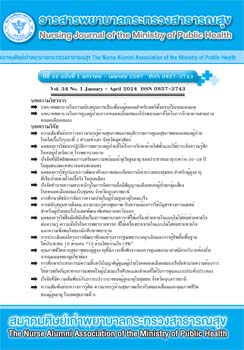The Role of Nurses in Supporting Companionship for Pregnant Women during Childbirth
Main Article Content
Abstract
Pregnant women, especially during their first pregnancy, often experience anxiety, fear, stress, and pain during labor and delivery. This situation can lead to negative childbirth experiences for both pregnant women and their families. Encouraging the use of a birth companion is a common practice in many countries and is regarded as an essential role that nurses should endorse. It is the responsibility of nurses to educate and clarify the particulars of preparation for both the pregnant women and their family, commencing from the pregnancy phase. Good preparation is helpful for pregnant women to decide on a suitable birth companion before delivery. Regarding the chosen companion, they should be trained to enhance knowledge of the different stages of labor and be capable of offering the necessary support and care to the pregnant woman. Being well-training, the companions for pregnant women are competent to provide necessary information, facilitate physical and emotional support, and act as a mediator of understanding. Therefore, throughout the antenatal and labor phases, nurses should play an important role in supporting and encouraging birth companions to effectively fulfill their vital roles in caring for and supporting the pregnant woman during childbirth. The activities of nurses in supporting birth companions for pregnant women during childbirth leads to several advantages, such as providing comfort to the pregnant woman during the waiting period and labor and significantly reducing the workload of obstetric nurses, especially in emotional support for the first-time pregnant women. However, in the current situation, most public hospitals in Thailand do not allow relatives to be companions in delivery room. As a result, pregnant women and their families opt for a costly caesarean section delivery to reduce the anxiety and duration of labor. Thus, the recommendation of guidelines for the preparation of birth companions should be considered and included in the hospital policy, while obstetric nurses should be prepared to support birth companions, by utilizing empirical evidence in their practices. This approach can significantly impact the success of having birth companions and reducing healthcare cost as well.
Article Details

This work is licensed under a Creative Commons Attribution-NonCommercial-NoDerivatives 4.0 International License.
บทความและรายงานวิจัยในวารสารพยาบาลกระทรวงสาธารณสุข เป็นความคิดเห็นของ ผู้เขียน มิใช่ของคณะผู้จัดทำ และมิใช่ความรับผิดชอบของสมาคมศิษย์เก่าพยาบาลกระทรวงสาธารณสุข ซึ่งสามารถนำไปอ้างอิงได้
References
Xuto P. Women during labour and postpartum periods. 2 ed. Chiangmai: N.P.T Printing; 2020.
Tongsong T. Obstetrics. 6th ed. Chiang Mai: Department of Obstetrics and Gynecology Faculty of Medicine Chiang Mai University; 2021.
Senanayake H, Wijesinghe RD, Nayar KR. Is the policy of allowing a female labor companion feasible
in developing countries? Results from a cross sectional study among Sri Lankan practitioners. BMC Pregnancy and Childbirth. 2017;17(1):392.
Sethi R, Gupta S, Oseni L, Mtimuni A, Rashidi T, Kachale F. The prevalence of disrespect and abuse during
facility-based maternity care in Malawi: evidence from direct observations of labor and delivery. Reproductive Health. 2017;14(1):111.
Bohren MA, Hofmeyr GJ, Sakala C, Fukuzawa RK, Cuthbert A. Continuous support for women during
childbirth. Cochrane database of systematic reviews. 2017(7).
Dubey K, Sharma N, Chawla D, Khatuja R, Jain S. Impact of birth companionship on maternal and fetal
outcomes in primigravida women in a government tertiary care center. Cureus. 2023;15(5):e38497.
Bohren MA, Berger BO, Munthe Kaas H, Tunçalp Ö. Perceptions and experiences of labour companionship:
a qualitative evidence synthesis. Cochrane Database of Systematic Reviews. 2019(3).
World Health Organization. Sexual, reproductive, maternal, newborn, child and adolescent health:
Policy survey, 2018-2019: Summary report [internet]. 2020 [cited 10 January 2024]. Avialable from:
https://www.who.int/publications/i/item/9789240004092
WHO Session. Journal of Obstetrics and Gynaecology Research. 2023;49(S1):87-9.
World Health Organization. The prevention and elimination of disrespect and abuse during facility-based
childbirth: WHO statement. World Health Organization [internet]. 2014. [cited 10 January 2024]. Avialable from: https://www.who.int/publications/i/item/WHO-RHR-14.23
Rungreangkulkij S, Ratinthorn A, Lumbiganon P, Zahroh RI, Hanson C, Dumont A, et al. Factors
influencing the implementation of labour companionship: formative qualitative research in Thailand.
BMJ open. 2022;12(5):e054946.
Tanglakmankhong K. Mismatch between childbirth expectations and childbirth experiences among
Thai Women. Journal of Health Science. 2017;20(3):525-32.
Kabakian Khasholian T, Bashour H, El Nemer A, Kharouf M, Elsheikh O, Group LCS, et al. Implementation
of a labour companionship model in three public hospitals in Arab middle income countries. Acta Paediatrica. 2018;107:35-43.
Munkhondya BMJ, Munkhondya TE, Chirwa E, Wang H. Efficacy of companion-integrated childbirth
preparation for childbirth fear, self-efficacy, and maternal support in primigravid women in Malawi. BMC
Pregnancy and Childbirth. 2020;20(1):48.
World Health Organization. Companion of choice during labour and childbirth for improved quality
of care: evidence-to-action brief [internet]. 2020 [cited on 10 January 2024]. Available from:
https://www.who.int/publications/i/item/WHO-SRH-20.13
De Mucio B, Binfa L, Ortiz J, Portela A. Status of national policy on companion of choice at birth in
Latin America and the Caribbean: Gaps and challenges. Revista Panamericana de Salud Pública
;44:e19.
Kabakian-Khasholian T, Portela A. Companion of choice at birth: factors affecting implementation.
BMC pregnancy and childbirth 2017;17(1):1-13.

